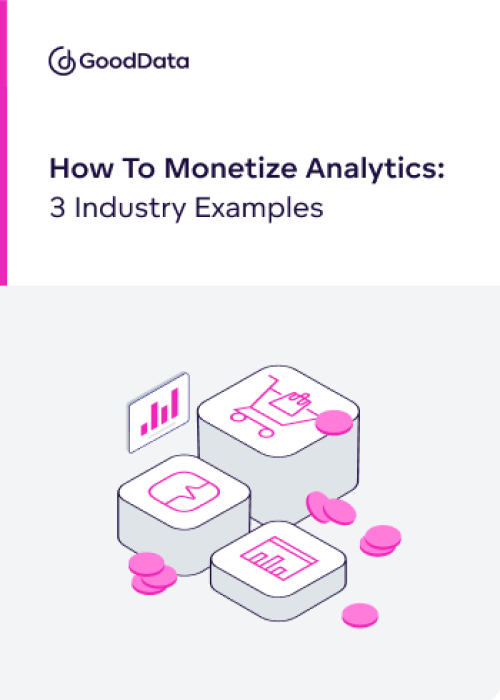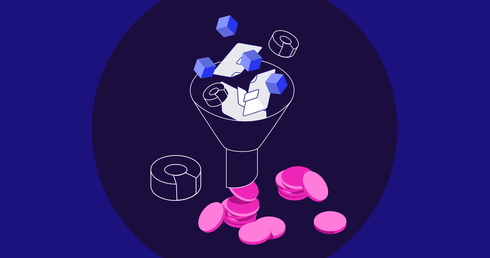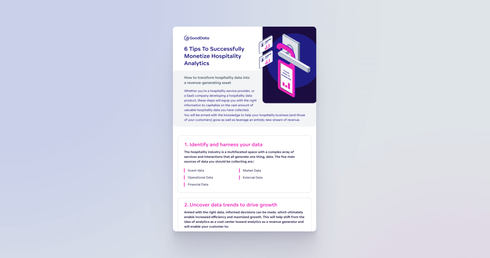Monetizing data, and the analysis of it, is not a new concept. Still, as data analytics and BI platforms evolve along with the needs of organizations, the opportunity to leverage monetization, and the benefits it brings, is greater than ever.
Moreover, while some industries are more obvious candidates than others, any vertical can extract new and increased revenue from data. So, if you’re not already making money from data and its analysis, now is the time.
Read on to understand why, how, and what to monetize as well as the prerequisites of a monetization-ready analytics solution — with real industry examples.
Why consider monetizing analytics?
The first step to take when considering analytics monetization is to shift from the idea of data analytics being a cost center to a revenue-generating asset. The more an organization focuses on the ROI of its data analytics implementation, the more easily it can identify opportunities to leverage it.
In simple terms, there are two ways to think about the monetization of data analytics. Direct monetization is where the customer/user is charged a fee (subscription or flat rate) for accessing all or certain parts of the analytics you provide to them. We’ll cover this in more detail below. Indirect monetization is a little less clear-cut but is an approach by which you derive increased revenue or business growth through your analytics. This still offers tangible results but rather than charging a fee directly linked to the analytics you provide, it adds value to your solution or product which in turn, has a positive impact on your revenue.
Good to know!
A data product is an application whose primary function is to generate, process, analyze, or leverage data to provide valuable insights, automate decisions, or enhance business processes. Data products can range from simple dashboards to complex machine learning models, but their core purpose is to deliver data-driven outputs that solve specific business problems or add value to users.
Types of monetization
Direct monetization opportunities
- Tiered data product: If you (plan to) provide a data product for your customers, building analytics into it can be done in a tiered structure, whereby you offer increasing levels of granularity and functionality in line with increases in pricing.
- External access via API: With this method, instead of embedding your analytics, you can offer access to the analytics via an API with a subscription fee charged. In this instance, white-labeling and theming within the analytics solution would ensure seamless brand identity, making the analytics look like your own product.
- Direct access to analytics dashboards: Similar to APIs, this option could be offered via a subscription fee with the customer accessing analytics by logging in to a stand-alone analytics solution (again with white-labeling to match your brand).
Other opportunities include:
- Ad hoc analytics against a defined data model
- Direct SQL access and packaged data feeds
- Jupyter Notebook integration: for data science or machine learning (ML) use cases
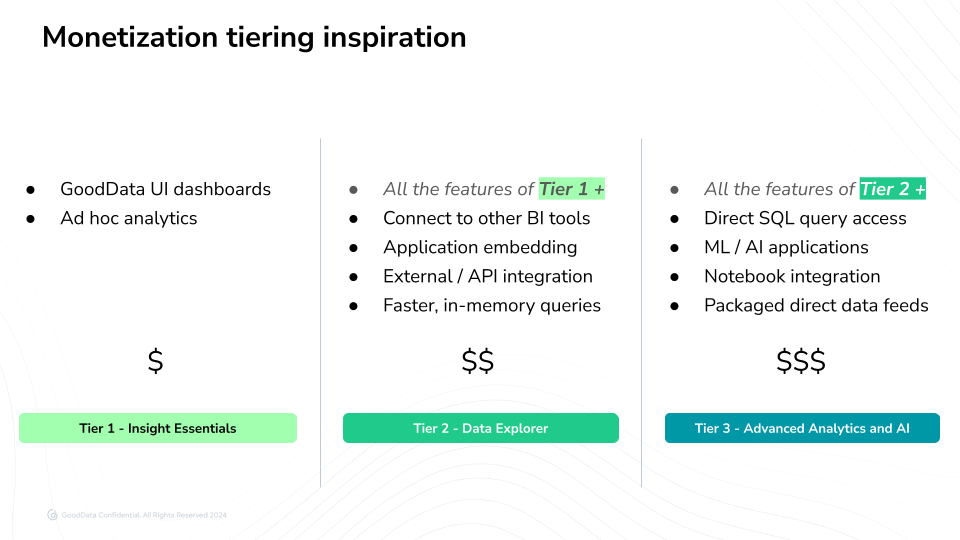
Indirect monetization opportunities
While direct monetization is possibly the more obvious benefit (and the new revenue stream that comes with it) there are also several other reasons to monetize your analytics. These include:
- Customer experience (CX): Offering a richer analytics experience to end-users improves CX, fosters repeat business, decreases churn, and adds value to your product.
- Revenue growth: Monetization isn’t always about charging for extra features or functions. Whether you use analytics within your organization or deliver it to customers, the added value it brings to business decision-making can provide revenue growth opportunities.
Must-have features for monetizing your analytics
In order to effectively monetize your data and the analysis of it, you need an analytics (or BI if you prefer) solution that equips you with the right technologies and features.
Embedded analytics
While it’s possible to offer monetizable analytics without embedding it (see API access above for example), delivering a seamless analytics experience will rely on robust embedding options. The result of embedding the visualizations will mean the relevant data insights and dashboards are easily accessible to all those who need them — eliminating the need for users to switch between multiple applications. It also enables you to customize the experience based on product tiers, thus enabling users to access only the level of analytics detail to which they have subscribed.
There are several ways to embed analytics, each method offering varying degrees of flexibility, customization, and ease of setup. When considering a monetizable analytics solution, it is important to understand which options are available and how well-supported they are.
- Basic embedding via IFrame: Simply copy and paste HTML code into the end user’s application or web portal.
- Web Components: Behave as a wrapper to provide simple integration of advanced analytics into your application with minimal coding required.
- Advanced embedding using SDK: Embed collections of pre-built dashboards and visualizations into end-user workflows using libraries (such as React SDK or JavaScript SDK).
- Embedding programmatically: Integrate dynamic visualizations or custom visualizations using third-party libraries and the provider's SDK — without the need to directly access the provider's interface.
While all of the above embedding types can be used for some level of data analytics monetization, the latter two provide significantly more customization opportunities which are particularly applicable to tiered data product offerings.
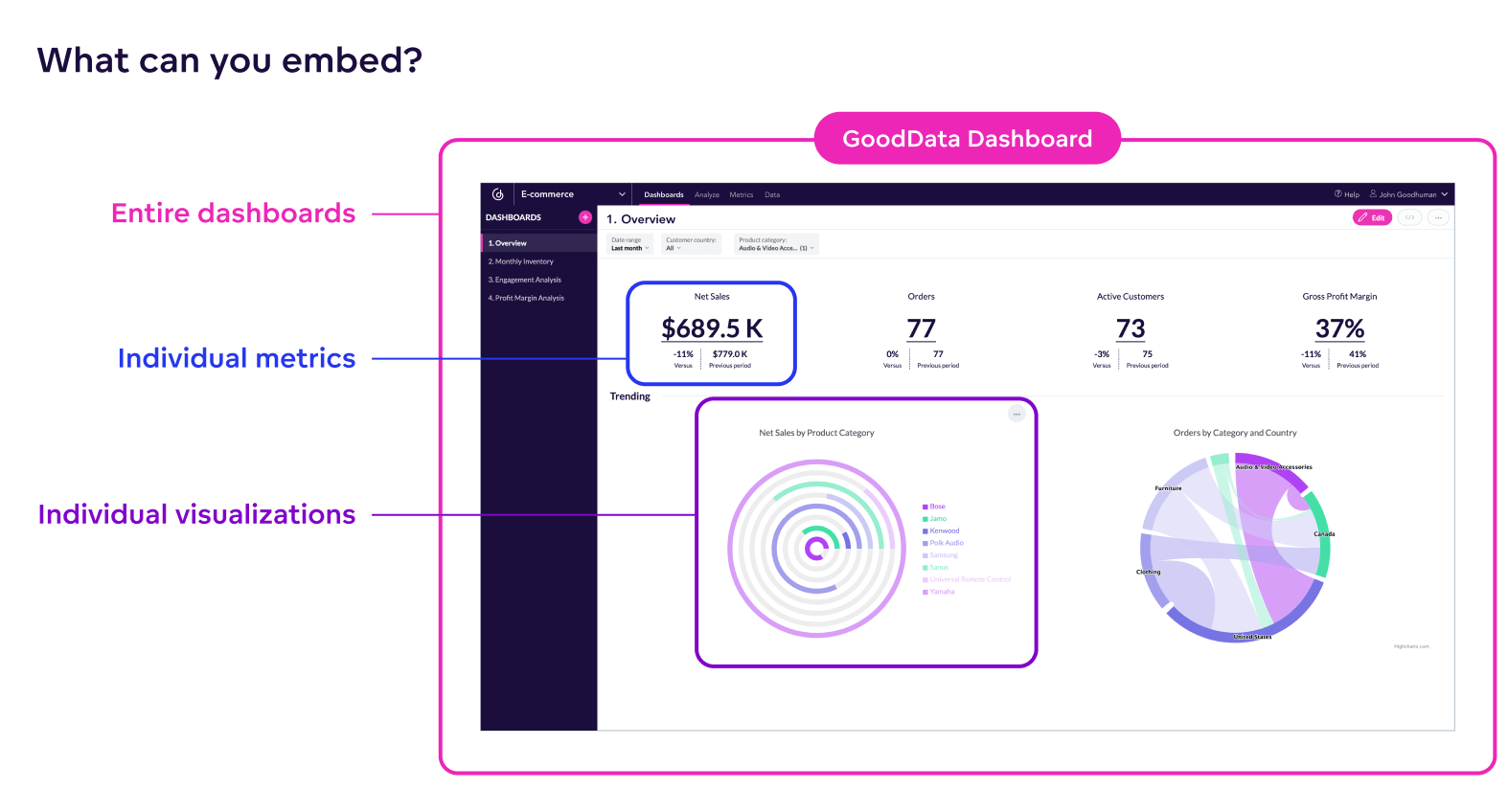
You can learn about the different embedding options in greater detail in this whitepaper.
Multi-tenant analytics
A few important points to factor in when monetizing data analytics are security, customization, and cost efficiency.
Multitenancy, or multi-tenant analytics, is an architectural approach where a single analytics solution serves multiple customers (tenants), each with its own separate and secure data storage and customizable front end. It covers the above points in the following way:
Cost efficiency, or predictable costs and significant savings, is one benefit of the analytics infrastructure being shared and distributed across multiple tenants (your customers). This enables you to grow your business and analytics (and the monetization of it) at a predictable rate with clear profit margins.
Governance and security are simplified when managing a single analytics instance. Multitenancy enables you to push new versions of the analytics to all, or specific customers, as needed — reducing admin overhead while streamlining resource allocation. Moreover, strict security and compliance measures mean users only have access to the data relevant to them.
Customization and flexibility are afforded to each customer. Customized (and customizable) analytics dashboards and reports can be distributed according to the needs of each business or based on their subscription tier.

Examples of data analytics monetization in different industries
Hospitality
The hospitality industry is a multifaceted space with a complex array of services and interactions that all generate data — customer interactions, bookings, reviews, inventory items, and more. Leveraging this data to inform business decisions and actions is where the potential gains lie. We can effectively group this data into the following five categories:
- Guest data: Information collected includes demographics, preferences, booking behaviors, and feedback.
- Operational data: Involves room occupancy rates, maintenance schedules, staffing, and supply chain logistics.
- Financial data: Encompasses revenue management, cost control, budgeting, and forecasting.
- Market data: Considers competitive pricing, market trends, and economic indicators.
- External data: Weather patterns, local events, and geopolitical factors impacting travel.
Like many verticals, the hospitality industry is complex, with several data challenges, including a plethora of data from multiple sources, further compounded by industry-specific hurdles like labor shortages, rising costs, and ever-higher guest expectations.
Read "The Analytics Monetization Playbook for Hospitality" for an in-depth guide to monetizing your hospitality data.

Revenue-generating opportunities in the hospitality space include:
- Improved guest experiences
- Maximized bookings
- Streamlined operations
E-commerce
The e-commerce industry is not dissimilar to hospitality in the huge diversity of data that is collected. As the e-commerce market continues to expand, attracting and retaining brands is essential for the health and growth of e-commerce platforms. A key strategy in achieving this is effectively utilizing and monetizing e-commerce data.
E-commerce data sources include:
- Site logs: Insights into user interactions, such as page visits.
- Website traffic and behavioral data: Understanding user navigation and product views.
- Marketing campaign data: Analyzing campaign effectiveness through metrics like click-through rates and ROI.
- Customer data: Demographics, preferences, and purchase history for personalized marketing.
- Order and payment data: Tracking order details, inventory, and secure payment processing.
Traditionally, e-commerce companies use these data points for internal analytics, monitoring campaigns, customer behavior, and inventory. However, as the business grows, basic analytics may no longer suffice, especially when managing multiple brands and vendors.
To address this, e-commerce platforms can monetize their data by offering vendors access to insights on sales, customer behavior, and market trends. This helps vendors manage their businesses more efficiently while providing the e-commerce platform with an additional revenue stream.
Learn more about leveraging analytics for e-commerce success.
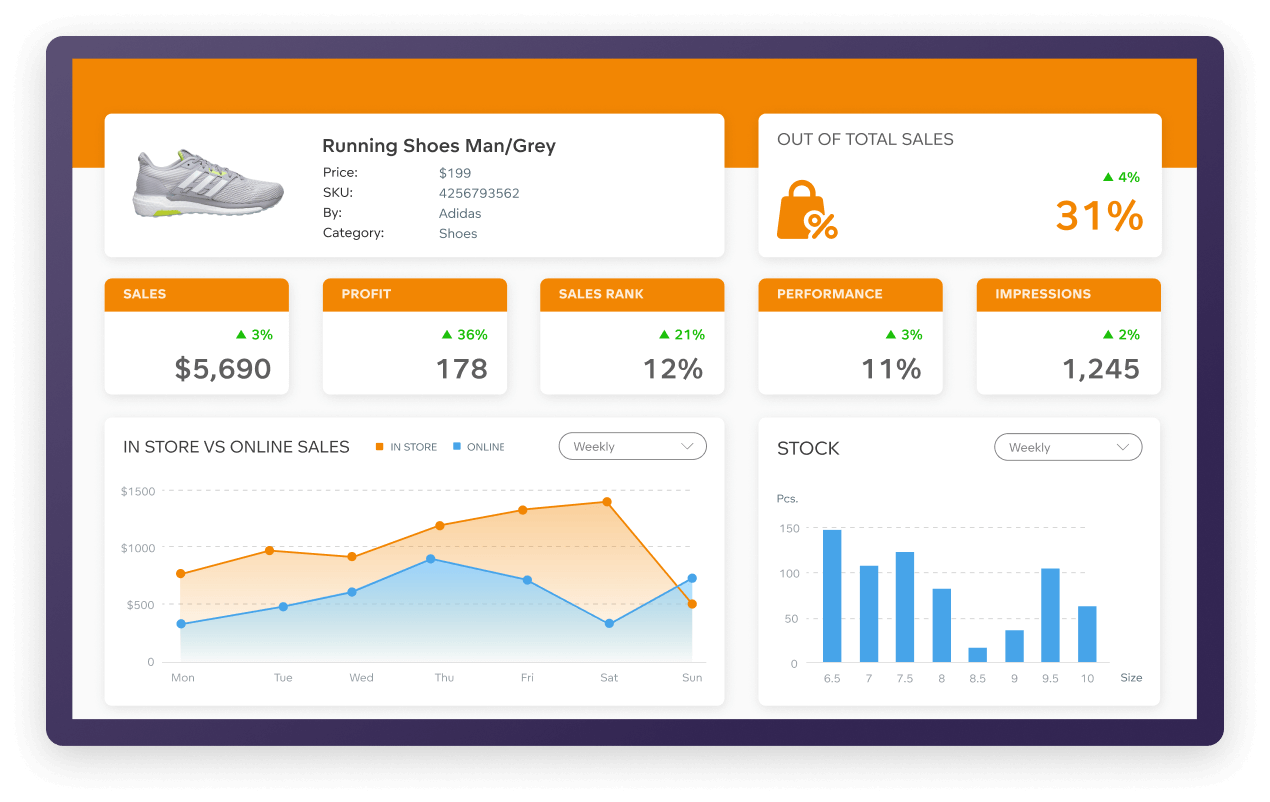
Revenue-generating opportunities in the e-commerce space include:
- Increased sales
- Accelerated business-critical decision-making
- Improved brand attraction and retention
Healthcare
Healthcare data refers to any information related to patients, medical practices, treatments, and health outcomes. Healthcare data includes:
- Clinical data: Patient medical records, lab results, imaging reports, and other data generated during healthcare visits.
- Operational data: Data related to the management and administration of healthcare facilities and services.
- Financial data: Information about the financial aspects of healthcare, such as billing or insurance claims.
- Pharmaceutical data: Data about drug development, clinical trials, and pharmaceutical sales.
- Patient-generated data: Information collected from smart wearable devices, health apps, and patient-reported outcomes.
Achieving successful data monetization in healthcare requires careful planning, respect for regulations, and a focus on creating value.
In healthcare, companies must be more careful with data monetization, as they work with the most sensitive data, which is patient data. Accordingly, it is worth considering the following key points while thinking about data monetization.
Data privacy and security
Making sure patient data is private and secure is of course particularly important within the healthcare industry. This also includes compliance and adherence to regulations like HIPAA (in the United States) and GDPR (in Europe). Finding an analytics solution compliant with such regulations should be top of your list.
Data quality
Having precise and dependable healthcare data is also a must-have. To achieve this, it is important to set up solid data management practices that keep the data accurate and consistent.
Enhanced technologies
Enhanced technologies, like artificial intelligence (AI), are crucial in healthcare data monetization due to the vast data volume. AI excels at discovering intricate patterns, enabling personalized care, real-time monitoring, and efficient resource allocation.
Learn about how Redica leverages analytics to help healthcare organizations reduce compliance risk.

Monetizing data analytics with GoodData
As you can see, whatever industry you cater to, the chances are it’s prime for the effective monetization of data. This includes both directly via paid data product tiers and API access as well as indirectly through increased revenue and cost optimization.
The go-to analytics platform for building monetizable analytics solutions? A multi-tenant, highly scalable, flexibly embeddable analytics platform like GoodData. Don’t just take our word for it though, read on to understand how organizations like Stackless, Fourth, and Zartico leveraged GoodData analytics to successfully monetize data.
Want to see it in action? Request a demo and we’ll show you, first-hand, how GoodData can turn your data into actionable, revenue-generating insights.
Continue Reading This Article
Enjoy this article as well as all of our content.
Does GoodData look like the better fit?
Get a demo now and see for yourself. It’s commitment-free.
